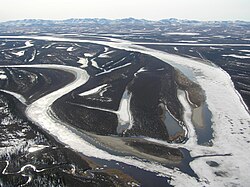Kobuk River
The Kobuk River (also Kooak, Kowak, Kubuk, Kuvuk, or Putnam) [1] is a river in the Arctic region of Alaska, in the United States. The river is about 280 miles (450 km) long,[1] and receives water from about 12,300 square miles (31,850 km2) of land. It is among the largest rivers in Alaska. It flows from the southernmost part of the Brooks Range, a mountain range 700 miles (1,100 km) long. [2] Its mouth is at the Kobuk River Delta, which is about 32 miles (51 km) long.[3]
| Kobuk River | |
|---|---|
| Mouth | Kobuk Delta |
| Length | 280 mi (451 km) |
Its watershed, ranging from 0 to 11,400 feet (0 to 3,475 m) above sea level, has a wide variety of landforms, including mountains, plateaus, and plains. The average elevation is 1,300 feet (400 m). The river's name, in the native Inuit language, means "big river". [4]
The river has been an important part of the lives of nearby people. Native people (the Inuit, Koyukans and others) have used the river as a source of food and transport for over 12,000 years. [5] In 1898, a gold rush called the "Kobuk River Stampede" happened. In 1980, 110 miles (177 km) of the river were deemed the Kobuk Wild and Scenic River.
Kobuk River Media
Permafrost regions along the Kobuk River
References
- ↑ 1.0 1.1 "USGS GNIS Detail: Kobuk River".
- ↑ "Kobuk River". United States National Park Service. Retrieved 2009-04-09.
- ↑ "USGS GNIS Detail: Kobuk River Delta".
- ↑ "Kobuk Valley FAQ". United States National Park Service. Retrieved 2009-04-09.
- ↑ Brabets, T.P., Hydrologic Data and a Proposed Water-Quality Monitoring Network for the Kobuk River Basin, Gates of the Arctic National Park and Preserve, and Kobuk Valley National Park, Alaska. U.S. Geological Survey, Water Resources Investigations Report 01-4141, 2001


